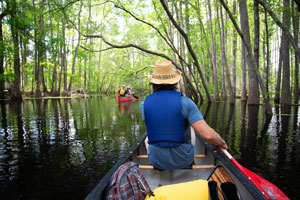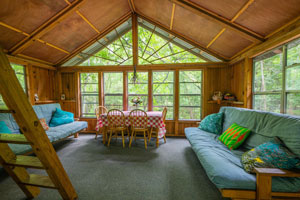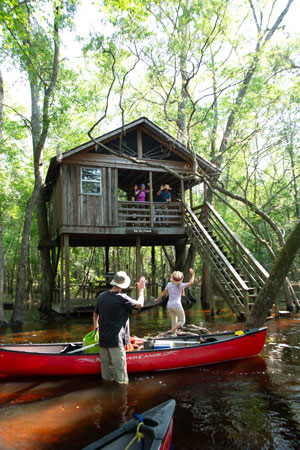
Leave your cares behind on a leisurely downriver paddle to this secluded destination.
Spending a day on the water with your closest friends. Camping overnight in a rustic, secluded treehouse. Unwinding around a campfire at the end of the night.
If this sounds like the makings of the perfect day that your adolescent, Huck Finn-inspired self would have loved, then your adult self will jump at the chance to recreate these treasured childhood memories.
Carolina Heritage Outfitters in St. George, South Carolina offers outdoor adventurers the opportunity to paddle a two-person canoe along the cypress-lined, rapid-free, blackwater Edisto River to three private treehouses for overnight stays.
“It’s a great way to escape from the day-to-day grind and get away from civilization,” says Chris Burbulak, owner. “It’s a great way to recharge and unwind.”
The Edisto is the longest free-flowing blackwater river in the United States, winding 250 miles from South Carolina’s Sandhills region to the tidelands at the Atlantic Ocean. It’s labeled a blackwater river for its distinctive tea-colored hue created by tannins leached from decaying leaves of trees and vegetation that grow along the river’s edge.
Slow-moving and scenic, the waterway runs through an ecological landscape featuring cypress-tupelo swamps, forest lands and vast floodplains.
The area also supports a diversity of wildlife that includes several nationally threatened and endangered species such as the peregrine falcon, red-cockaded woodpecker and wood stork.
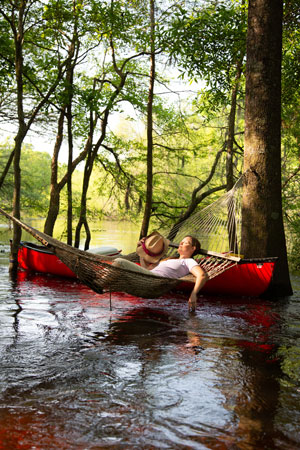 In addition, paddlers might encounter a hawk soaring overhead or any number of the dozens of turtle species that live in the river. Great blue herons, egrets, pileated woodpeckers, wood ducks, wild turkeys, deer, muskrats and raccoons also call the 150-acre Edisto River Refuge home.
In addition, paddlers might encounter a hawk soaring overhead or any number of the dozens of turtle species that live in the river. Great blue herons, egrets, pileated woodpeckers, wood ducks, wild turkeys, deer, muskrats and raccoons also call the 150-acre Edisto River Refuge home.
Don’t let the peaceful, serene nature of the surroundings fool you, however. Adventure awaits.
“The trips are all unguided. That’s what makes it more of an adventure,” Burbulak says.
Carolina Heritage rents two-person canoes and kayaks for overnight and day trips. The outfitter sends off its adventurers with a vessel, paddles, personal flotation devices, safety orientation and directions.
“We want people to have fun, but we also want them to be safe,” says Burbulak.
Traveling through the largest private wildlife refuge on the river, adventurers can access the treehouses only by canoe. The canoes can hold more gear than kayaks, and they are more adept at handling the Edisto’s sharp curves.
While the paddles are open to novice and experienced outdoor enthusiasts, spring and fall trips require more canoeing skills. The water is higher and faster during those seasons than in the summer.
Because the outfitter has only one treehouse shuttle per day to the launch site upstream, time is of the essence as well. Overnight adventurers must meet at the outpost by 9:30 a.m. to have plenty of daylight to reach the treehouses.
This two-day downriver adventure totals 23 miles. The paddle covers about 13 miles on day one from the put-in to the treehouses and 10 miles on day two to return to the outpost. The first-day paddle takes four to five hours, and the second-day trip takes three to four hours.
Although most visitors stay one night, additional overnights can be arranged.
To spend the night, guests can choose from three treehouses that are located on an 80-acre island within the private refuge. Positioned out of sight from each other, the wooden structures rise from the swamp
to tower 15 to 20 feet above the forest floor.
The treehouses sleep up to three, six or eight people, and they’re available from March 1 through the end of November.
Guests only need to bringfood, drinking water, sleeping bags and personal belongings such as pillows, towels and rain gear – just in case. Otherwise, the treehouses are stocked with anything else they’ll need for their overnight stay.
Amenities include a kitchen area with a table and chairs, propane stove, pots and pans, plates, utensils, a dining deck with an outdoor gas grill, benches, camp chairs, torches, oil candles and rechargeable lanterns.
A screened sleeping loft has one or two futon mattresses, depending on the size of the unit. Futons on the main level also fold out to accommodate an additional sleeping area.
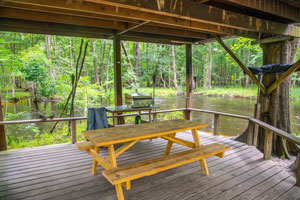 While the treehouses have no electricity or running water, outhouse facilities are located near each unit. Campers can wash up in the river.
While the treehouses have no electricity or running water, outhouse facilities are located near each unit. Campers can wash up in the river.
Entertainment opportunities are boundless. Guests can swim, fish for bass or bream, lounge in a rope hammock, enjoy the river view, listen to the running water, read a book, play cards or board games, cook or – gasp – just talk to each other.
The island also includes walking trails for exploring. A trail leads to each treehouse, and the main trail to the road is a 1-mile hike round-trip.
Once the sun goes down, campers can gather around a fire pit to tell stories, relive the day’s adventures, start a sing-along and roast hot dogs or marshmallows. Rustling trees, croaking frogs and hooting owls can serenade them to sleep.
The surround sound of the habitat at daybreak is just as vocal as the last call at night. “When you wake up in the morning, you can hear nature come alive,” says Burbulak.
Overnight guests have other sleeping options besides the treehouses as well.
“We have spots on our property for primitive camping,” Burbulak says. “If the water is low enough, there are plenty of sandbars where people can pull up and camp as well.”
However, the outfitter’s most popular canoe rental is a 10-mile day trip. Adventurers meet at the outpost on Highway 15 to catch the shuttle to the launch site and meander down the waterway. In the summer, the Edisto is relatively shallow, and its banks are sandy and forgiving – ideal conditions to take a dip in the spring-fed river or to stop for a picnic lunch.
This trip takes three to four hours – or all day for those who can elevate relaxation into an art form, and it ends at the outpost parking lot.
Far and Wide
While most of the clientele is from South Carolina, North Carolina or Georgia, others have come from up and down the East and West coasts, Alaska and even Australia and Europe. Children who make the trip should be at least 11 years old.
Regardless of how far and wide his customers travel to explore the Edisto, Burbulak wants them to have an unforgettable experience.
“They’re out in the middle of nowhere. We want them to enjoy the sense of adventure and camaraderie with each other,” he says.
By Morgan Davis
